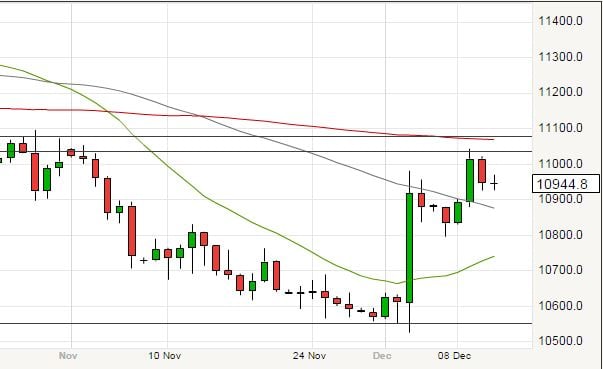EUR/USD at Best Exchange Rate Since November But Deutsche Bank See Slower GDP Growth Ahead
The euro exchange rate complex retains a positive bias but further advances could be constrained by some well established resistance points.

The EUR/USD conversion hit a best of 1.10 this week marking a high-point in the impressive post-ECB rally.
Momentum remains positively aligned, however we hear of some significant resistance points ahead which will have to be broken to stoke further buying interest.
The latest leg higher in the building trend is widely attributed to European Central Bank (ECB) Governing Council member Ewald Nowotny's comments made in Vienna earlier.
Nowotny criticised the “absurd” expectations for the ECB stimulus package.
Nowotny is quoted as saying, “It was absurd what expectations were expressed, I believe it was really a massive failing of market analysts. I don’t believe the ECB’s communications policy gave a false signal.”
Harsh words indeed, and a further lesson for markets who now clearly don't won't to be caught on the wrong end of euro bets for some time to come.
On the 3rd of December the euro powered higher in a spectacular rally as markets were shown to have been overly confident that the ECB was going to announce agressive policy changes.
Following the rollicking from Nowotny, the EUR and bond yields pushed higher as the message sunk in that the area around 1.10 could well be the new normal.
Those watching the euro to dollar rate would note the inter-bank rate at 1.0964 while high street banks are closer to 1.0550 in their international payment rates. This is due to the deep spreads they charge when passing on currency.
Independents are tighter on the spread they offer you and are quoted towards 1.0850-1.090 as they are more flexible on the spread delivered when trasferring your money.
However, the rally in the euro exchange rate complex could soon be tested.
"EURUSD is approaching strong resistance in the 1.1030/80 region, which includes the 100dma, 200dma and congestion. The downside is likely to be limited to 1.0815/1.0775," say Lloyds Bank in a note to clients.
EUR/USD Monitor Resistance at 1.1096 as Momentum Builds
Turning to strategy implications, Swissquote Bank, from Gland in Sitzerland, say the euro to dollar exchange rate conversion is eyeing resistance at 1.1096.
The bank states, “EUR/USD has increased and the pair is now is now in a clear bullish momentum. Hourly resistance at 1.0981 (03/12/2015) has been broken.
“Hourly support lies at 1.0796 (07/12/2015 low). Stronger support lies at 1.0524 (03/12/2015 low). Expected to target resistance at 1.1096.
“In the longer term, the technical structure favours a bearish bias as long as resistance holds. Key resistance is located region at 1.1453 (range high) and 1.1640 (11/11/2005 low) is likely to cap any price appreciation.
“The current technical deteriorations favours a gradual decline towards the support at 1.0504 (21/03/2003 low).”
Deutsche Bank: Slower Growth in 2017
Turning to the fundamental backdrop Deutsche Bank have updated clients with a note that confirms the economic tempo in the Eurozone will slow in 2017.
"We expect euro area GDP growth to be broadly unchanged at 1.6% in 2016, modestly above trend. Contrary to consensus, we expect GDP growth to slow to 1.5% in 2017 as supply cuts push oil prices higher, monetary and fiscal stimulus start to reverse and political risks rise (consensus: 1.8%)," says a note from the German Bank.
Deutsche Bank's baseline is for no further ECB easing; something that could well ensure EURUSD exchange rate levels keep above the parity point.
That said, inflation is said to be the main driver of ECB thinking.
"Despite the prospect of slower growth in 2017, the ECB will need to start thinking about a tapering strategy by the end of next year. The ECB will be led by inflation, not growth. Even modest above trend growth means core inflation will continue to rise. Our currency and oil price forecasts add further to inflation in 2017-2018," say Deutsche Bank.
In terms of risk scenarios, the recent fall in oil prices if sustained would represent an upside risk to growth and a downside risk for inflation.
December confirmed that the ECB will continue to be reactive and leave policy unchanged unless inflation expectations become dis-anchored. China remains a downside risk to both growth and inflation. So does European politics.
All these factors could feed a lower euro in the year ahead.





